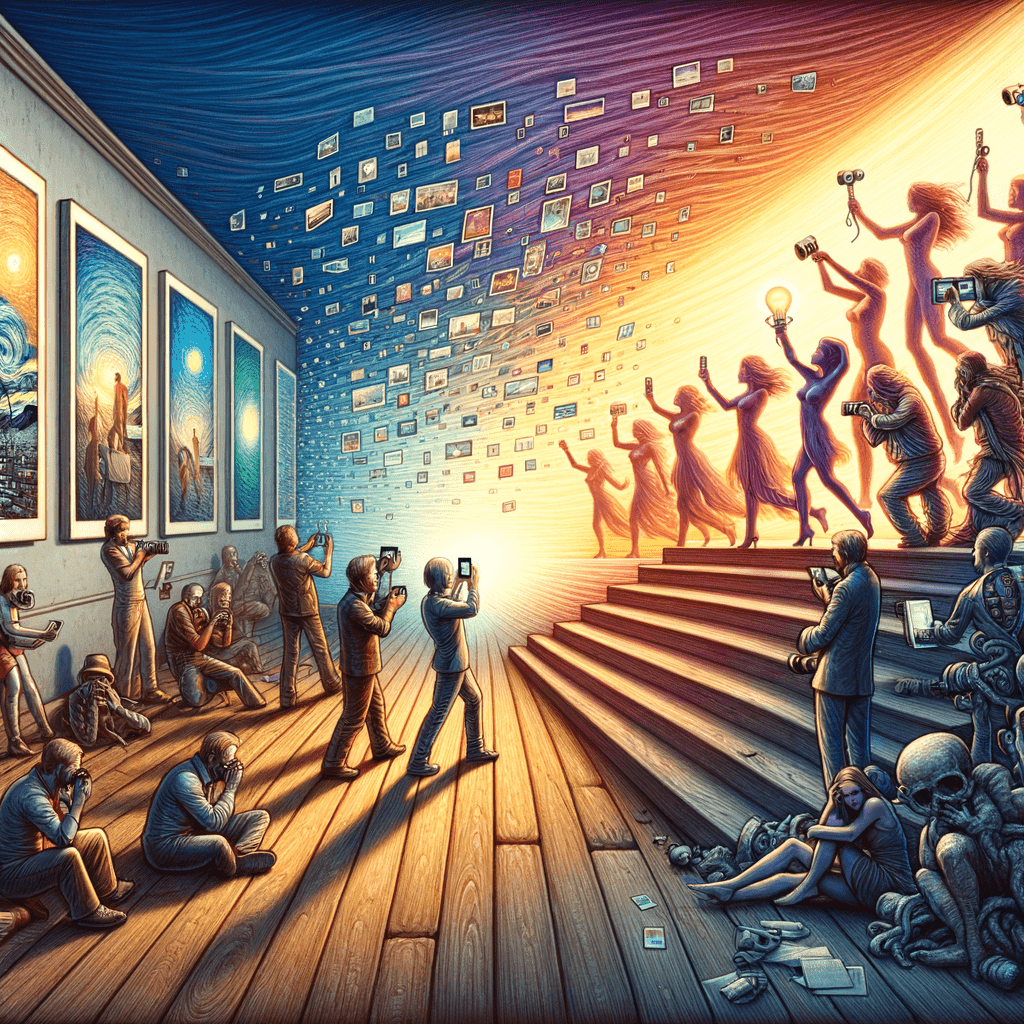Analyze how art criticism has changed with the advent of social media, transforming the way art is discussed, interpreted, and evaluated.
Art criticism has undergone a radical transformation with the advent of social media. This article explores how art criticism has changed, transforming the way art is discussed, interpreted, and evaluated.
Introduction to Traditional Art Criticism
The traditional art critique has deep roots in art history. Historically, art criticism was dominated by experts and academics who published their opinions in specialized journals and newspapers. These critics had significant influence in determining the value and reputation of a work of art.
Over time, art criticism became an increasingly formalized discipline, with prominent figures like Giorgio Vasari in the Renaissance, who helped establish aesthetic and historical canons through his work “Lives of the Most Excellent Painters, Sculptors, and Architects.” In the 18th and 19th centuries, critics like Denis Diderot and John Ruskin further developed the field, bringing art criticism to a broader audience and helping to shape public opinion about art.
During the 20th century, art criticism continued to evolve under the influence of artistic movements such as modernism and postmodernism. Influential critics like Clement Greenberg played a crucial role in promoting emerging artists like Jackson Pollock and in defining the aesthetic qualities of contemporary art. At the same time, figures like Harold Rosenberg introduced concepts such as “action painting,” further expanding the critical discourse.
With the advent of the digital age and the Internet, art criticism has undergone a significant transformation. Online platforms and social media have democratized access to criticism, allowing a wider range of voices to participate in the artistic discourse. Blogs, forums, and content-sharing platforms have enabled independent critics and the general public to express their opinions and influence the art market in new and often unpredictable ways.
Despite these changes, traditional art criticism continues to play an important role. Reviews published in academic journals and influential newspapers remain highly respected and can significantly impact the fame and valuation of artworks. However, the field of art criticism is now more diverse and dynamic than ever, reflecting the changing dynamics of art production and consumption in the modern era.
The Role of Art Galleries
Art galleries have always played a crucial role in the promotion and critique of artworks. Exhibitions organized by galleries were often accompanied by critical reviews that helped shape public opinion about the displayed art.
Functions of Art Galleries
- Promozione di artisti emergenti
- Organizzazione di mostre e eventi
- Collaborazione con critici d’arte per recensioni e articoli
The Advent of Social Media
With the advent of social media, the landscape of art criticism has undergone a significant transformation. Platforms like Instagram, Facebook, and Twitter have democratized art criticism, allowing anyone to express their opinion about a work of art.
Impact of Social Media on Art Criticism
- Accessibilità: Chiunque può diventare un critico d’arte
- Interazione: Maggiore interazione tra artisti e pubblico
- Visibilità: Maggiore visibilità per artisti emergenti
Case Study: The Influence of Instagram
Instagram is one of the most influential platforms in the world of contemporary art. Artists and critics use Instagram to share their works and opinions, reaching a global audience.
Examples of Artists on Instagram
- Yayoi Kusama: Conosciuta per le sue installazioni immersive, Kusama utilizza Instagram per condividere le sue opere con milioni di follower.
- Ai Weiwei: L’artista e attivista cinese utilizza Instagram per promuovere le sue opere e le sue cause sociali.
Statistics on the Use of Social Media in Art
According to a report by Artsy, 79% of art buyers use Instagram to discover new works and artists. This highlights the growing importance of social media in the art world.
Advantages and Disadvantages of Art Criticism on Social Media
Art criticism on social media presents both advantages and disadvantages. On one hand, it offers a democratic and accessible platform; on the other, it can lead to superficial evaluations of artwork.
Advantages
- Accessibilità: Chiunque può esprimere la propria opinione
- Interazione: Maggiore dialogo tra artisti e pubblico
- Visibilità: Maggiore esposizione per artisti emergenti
Svantaggi
- Superficialità: Recensioni spesso brevi e poco approfondite
- Bias: Opinioni influenzate da tendenze e popolarità
- Qualità: Difficoltà nel distinguere critiche di qualità da quelle meno valide
Conclusione
In conclusione, la critica d’arte ha subito una trasformazione significativa con l’avvento dei social media. Mentre le gallerie d’arte e i critici tradizionali continuano a giocare un ruolo importante, i social media hanno democratizzato la critica d’arte, rendendola più accessibile e interattiva. Tuttavia, è importante essere consapevoli dei potenziali svantaggi e cercare di mantenere un equilibrio tra qualità e accessibilità.
La critica d’arte sui social media rappresenta una nuova era nella valutazione e nell’interpretazione dell’arte, offrendo opportunità senza precedenti per artisti e critici di tutto il mondo.




